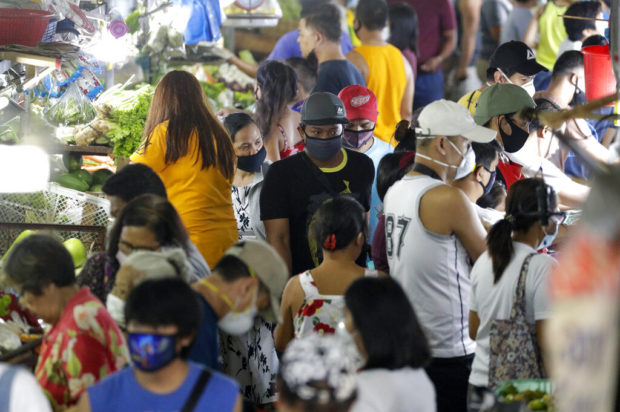
Men wearing protective masks buy food as people rush before the Munoz market closes for its morning business as they cut their operations to four hours a day as part of the enhanced community quarantine to prevent the spread of the new coronavirus in Metro Manila Thursday, March 19, 2020. (Photo by AARON FAVILA / AP)
MANILA, Philippines — The World Health Organization (WHO) cautioned Philippine authorities on Tuesday to consider the “epidemiological situation” should it decide to lift the Luzon lockdown as scheduled on Easter Sunday, especially that it does not see the coronavirus threat to go away in at least a month.
WHO Western Pacific regional director Takeshi Kasai said that just as the government made careful considerations in imposing the lockdown on Luzon two weeks ago, the same should be done if it would proceed with reopening the island.
“Obviously, this measure can’t continue forever. At some point, the government needs to think [about] when to lift this measure. When you do that, we have to make careful considerations of the epidemiological situation and impact of the lockdown,” Kasai told reporters in a virtual press briefing. (See related story on Page A3.)
Balance and control
“We may have to peel one by one and not just immediately lift those public health measures which were bundled with the lockdown to balance and control the disease and to bring back the society back to normal,” he said.
Kasai stressed that for the lockdown to be effective, authorities should continue to find, isolate and treat the positive cases, and trace and place on quarantine their contacts who may have been infected.
Health Undersecretary Maria Rosario Vergeire said that so far the Department of Health (DOH) has yet to make a recommendation to the Inter-Agency Task Force on Emerging Infectious Diseases on the lockdown. The DOH was still “meeting with experts” for an evaluation of the measure, she added.
On Tuesday, the DOH recorded the country’s single largest daily increase in infections as the agency ramped up testing.
Ten more deaths took the toll to 88, while the tally of infections rose to 2,084, with 538 additional cases, Vergeire said.
Fatality rate ‘quite high’
The WHO said that the Philippines’ coronavirus fatality rate appears to be “quite high” due in part to its testing strategy.
“The Philippines’ testing strategy prioritizes severe cases. People with severe disease are more likely to die than those with mild disease, so the proportion goes up. The high proportion of deaths is essentially because of the way [it] chose to test, influenced by the global shortage of laboratory supplies, reagents,” Matthew Griffith, WHO technical adviser, said.
From a high of 8 percent, the country’s fatality rate is now 4.2 percent, still over the global average of 4 percent.
Vergeire maintained that the increase in the number of new cases was due to the expansion of the country’s testing capacity.
The DOH now has six operational laboratories capable of testing for SARS-CoV-2, the virus that causes COVID-19. It remains unclear, however, when the DOH would be able to say it has already seen a trend in COVID-19 cases. At least 49 more hospitals are seeking government approval to function as testing centers.
“Our objective is to lower the number of cases until it reaches zero,” Vergeire said on the 17th day of the monthlong lockdown.
Long-term battle
While the WHO understands the public’s concern over the virus, Kasai said that as of now it still could not say how long it may take to control the spread of COVID-19. He noted that there is still “no evidence” to prove the theory that the virus will go away with the warmer summer climate.
“There are people around the world that are doing their best to fight COVID-19. But it is unlikely that this virus will disappear next week or even next month. This battle is going to be a long-term battle,” Kasai said.
“We want every country to respond according to their local situations and prepare for a large-scale community outbreak. We want them to think of a strategy to bring back, in a balanced way, the societies back to normal as much as possible,” he added.
On Monday, the Food and Drug Administration accredited five rapid test kits from Singapore and China but stressed that this should only be used in clinical settings. Vergeire acknowledged that the rapid test kits would help people know in an “indirect way” if they have contracted the virus.
“The PCR (polymerase chain reaction-based) tests remain to be the gold standard,” she said, adding that those who would test positive using the rapid test kits would still need to undergo confirmatory testing.
Vergeire said the DOH had sent to the five subnational laboratories kits that could process 40,700 tests.
As of Monday, 15,337 tests have been done. This total includes 2,388 positive results (counting as well the retests), 11,129 negative tests and 1,820 “equivocal results”—tests that are either positive or negative. Vergeire said the remaining kits could still process more than 85,000 tests.
—WITH A REPORT FROM THE WIRES